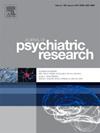重度抑郁障碍的被动自杀意念:抗抑郁治疗的预后作用和效果
IF 3.7
2区 医学
Q1 PSYCHIATRY
引用次数: 0
摘要
背景和目的被动自杀意念(PSI)——被定义为没有任何行动意图的死亡欲望——是一个相对未被充分研究的现象。本研究探讨其在重度抑郁障碍(MDD)中的预后作用及其在抗抑郁治疗期间的演变。方法482例门诊患者(男性30%;平均年龄= 43.14±12.46岁)。在基线和6周后再次进行临床评估,评估抑郁和轻度躁狂症状、共病焦虑和童年创伤。PSI采用简明健康风险跟踪自我报告量表(CHRT_PSI;得分范围0-16)。为了将PSI与绝望等相关抑郁症状区分开来,在分析临床特征和治疗反应时使用保守阈值(CHRT_PSI≥5)。在评估PSI对自杀行为的预测准确性时,采用更广泛、更敏感的阈值(CHRT_PSI≥4)。结果与无PSI患者相比,PSI组患者(n = 283;(59%)表现出更严重的抑郁症状,更高的共病焦虑症发生率,以及更多的童年创伤,包括身体和精神虐待。虽然PSI在预测自杀行为方面表现出适度的总体准确性(37% - 46%),但其敏感性(66% - 85%)和阴性预测值(78% - 89%)都很好。PSI也是抗抑郁药物反应的重要预测指标,即使在调整了年龄、性别、抑郁严重程度和童年虐待史后,这种影响仍然很明显。在完成6周治疗的270例PSI患者中,96例PSI缓解。失眠和快感缺乏与较差的结果有关,而健谈与较高的缓解可能性有关。结论psi在重度抑郁症患者中较为常见,且预后较差。失眠可能成为治疗期间PSI缓解的障碍。本文章由计算机程序翻译,如有差异,请以英文原文为准。
Passive suicide ideation in major depressive disorder: prognostic role and effect of antidepressant treatment
Background and aims
Passive suicidal ideation (PSI)—defined as the desire to die without any intent to act—is a relatively understudied phenomenon. This study investigated its prognostic role in major depressive disorder (MDD) and its evolution during antidepressant treatment.
Methods
A total of 482 outpatients (30 % male; mean age = 43.14 ± 12.46 years) from the CO-MED trial were included. Clinical evaluations were conducted at baseline and again after 6 weeks, assessing depressive and hypomanic symptoms, comorbid anxiety, and childhood trauma. PSI was measured using four targeted items from the Concise Health Risk Tracking Self-Report scale (CHRT_PSI; score range 0–16). To distinguish PSI from related depressive symptoms such as hopelessness, a conservative threshold (CHRT_PSI ≥5) was used when analyzing clinical features and treatment response. A broader, more sensitive threshold (CHRT_PSI ≥4) was applied when evaluating PSI's predictive accuracy for suicidal behavior.
Results
Compared to patients without PSI, those in the PSI group (n = 283; 59 %) exhibited more severe depressive symptoms, higher rates of comorbid anxiety disorders, and more childhood traumas, including both physical and emotional abuse. While PSI showed modest overall accuracy (37 %–46 %) in predicting suicidal behavior, its sensitivity (66 %–85 %) and negative predictive value (78 %–89 %) were good. PSI was also a significant predictor of response to antidepressants, an effect that remained robust even after adjusting for age, sex, depression severity, and history of childhood maltreatment. Among the 270 PSI patients who completed 6 weeks of treatment, 96 achieved remission from PSI. Insomnia and anhedonia were associated with poorer outcomes, while talkativeness was linked to a higher likelihood of remission.
Conclusion
PSI is common in individuals with MDD and is associated with a worse prognosis. Insomnia may act as a barrier to PSI remission during treatment.
求助全文
通过发布文献求助,成功后即可免费获取论文全文。
去求助
来源期刊

Journal of psychiatric research
医学-精神病学
CiteScore
7.30
自引率
2.10%
发文量
622
审稿时长
130 days
期刊介绍:
Founded in 1961 to report on the latest work in psychiatry and cognate disciplines, the Journal of Psychiatric Research is dedicated to innovative and timely studies of four important areas of research:
(1) clinical studies of all disciplines relating to psychiatric illness, as well as normal human behaviour, including biochemical, physiological, genetic, environmental, social, psychological and epidemiological factors;
(2) basic studies pertaining to psychiatry in such fields as neuropsychopharmacology, neuroendocrinology, electrophysiology, genetics, experimental psychology and epidemiology;
(3) the growing application of clinical laboratory techniques in psychiatry, including imagery and spectroscopy of the brain, molecular biology and computer sciences;
 求助内容:
求助内容: 应助结果提醒方式:
应助结果提醒方式:


